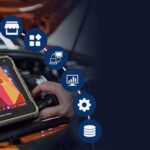As car enthusiasts and DIY mechanics, we’re always looking for ways to understand our vehicles better. The On-Board Diagnostics II (OBD2) system is a powerful tool, providing access to a wealth of data about your car’s performance and health. With the increasing prevalence of HDMI displays, a common question arises: can you directly connect an OBD2 port to an HDMI port using an Obd2 To Hdmi Cable?
To understand this, let’s delve into what OBD2 and HDMI are and how they function. OBD2 is a standardized system that allows you to access your car’s diagnostic information via a 16-pin port, typically located under the dashboard. This system communicates using various protocols like CANBUS, allowing tools to request and receive real-time data from different vehicle modules. HDMI, on the other hand, is a digital interface for transmitting high-definition video and audio signals between devices like media players and displays.
Alt text: Locating the OBD2 port beneath the steering wheel in a vehicle interior, a crucial step for accessing car diagnostics.
Directly connecting an obd2 to hdmi cable for data transfer is not feasible because they operate on fundamentally different protocols and serve distinct purposes. OBD2 ports output data signals related to vehicle diagnostics, while HDMI ports are designed for video and audio output. There’s no inherent compatibility between these two. A simple cable cannot bridge this gap.
However, the desire to display OBD2 data on an HDMI screen is understandable. Imagine viewing real-time engine parameters, sensor readings, or even diagnostic trouble codes on your car’s infotainment screen or an external monitor. While a direct obd2 to hdmi cable doesn’t exist for data conversion, there are solutions to achieve this.
One common method involves using an OBD2 scanner or adapter that is specifically designed to output data in a video format compatible with HDMI. These devices often read data from the OBD2 port, process it, and then output it as a visual display signal through an HDMI port. Some advanced OBD2 scanners come equipped with HDMI output capabilities, allowing you to connect them directly to an HDMI display.
Alt text: A handheld OBD2 scanner displaying diagnostic data on its integrated screen, a tool used for vehicle health checks.
Another approach involves using an OBD2 Bluetooth or Wi-Fi adapter in conjunction with a smartphone or tablet and screen mirroring or casting technology. In this setup, the OBD2 adapter wirelessly transmits data to your mobile device. Apps on your device can then interpret and display this data. To get this onto an HDMI screen, you would use your phone or tablet’s screen mirroring feature (if supported) or a wired HDMI adapter for your device to connect to an HDMI input on a larger display.
For more advanced users interested in deeper vehicle communication, understanding protocols like CANBUS is crucial. As discussed in automotive forums, accessing raw CANBUS data and interpreting specific Parameter IDs (PIDs) often requires specialized tools and knowledge. Direct manipulation of CANBUS data streams to output via HDMI is a complex task, generally beyond the scope of simple consumer-grade obd2 to hdmi cable solutions.
In conclusion, while a direct obd2 to hdmi cable for simple data transfer doesn’t exist due to protocol differences, displaying OBD2 data on HDMI screens is achievable. Solutions range from specialized OBD2 scanners with HDMI output to wireless adapters combined with mobile devices and screen mirroring. Choosing the right approach depends on your needs, technical expertise, and the level of diagnostic information you wish to visualize.
